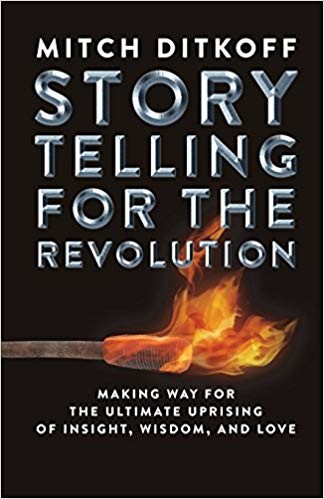Speak the Truth
Posted by Mitch Ditkoff at 11:12 AM | Comments (0)
May 24, 2012Even the Sky is Not the Limit

Posted by Mitch Ditkoff at 11:21 PM | Comments (0)
May 20, 2012The Man Who Invented the Wheel

Since 1986, I've asked more than 5,000 people where and when they get their best ideas. The answers have been all over the place -- everything from "in the shower" to "ironing" to "in my dreams."
But no matter how diverse the answers are, 98% of all respondents say the same thing -- their best ideas happen OUTSIDE of the workplace. I find this fascinating -- especially when you consider how much time we spend at work -- and how much brilliance is expected of us.
That's one of the reasons why I wrote Awake at the Wheel. I wanted to give people a more dependable way to conjure up (and commit to) the kind of meaningful ideas that make a difference in the world.
Listen to a three-minute intro. Read what others have to say about it. Buy one for your boss, spouse, kids, chiropractor, CEO, mother, friend, team, accountant, neighbor, numerologist, or business partner.
PS: The book was a Silver Medalist in the 2009 Axiom Business Books Awards competition (scroll down to category #22).
Posted by Mitch Ditkoff at 01:23 AM | Comments (0)
May 18, 2012How Business Collaboration is Like Dancing Tango
NOTE: The following article is authored by Sarah Martha Jacob, founder of Tangolia.
There are two kinds of people in the world. One looks at a new possibility through the eyes of fear. The other looks at a new possibility through the eyes of faith.
I should know. I worked with both kinds of people for four years at one of the largest private investment firms in the country.
So it really should have been no surprise to me when I heard their two polar opposite responses on the day I declared I was leaving my high paying job as a portfolio manager to travel the world and dance Argentine tango.
"You are making a huge mistake," said the fear group.
"You're a rock star," said the faith group.
The fear group thought I was stark raving mad to be leaving a well-paying career to go follow .... what? My dreams?
"Beware of the gap on your resume, you silly girl," was their mantra.
The faith group thought I was a genius to go exploring, at the ripe age of 29, given that I had no mortgage or kids holding me back.
"Go! Do it for all of us," was the excited whisper beneath their words of encouragement.
Whether you make career choices out of fear or faith, it's not every day you see someone gliding off the corporate cliff and onto dance floors in other hemispheres.
I didn't see it as a savvy career move as much as a campaign to save my soul.
Today my career is thriving as a result of the set of tools I picked up during my tango travels.
How are tango skills relevant to business?
For starters, dancing tango well requires collaborating with a partner to create something you cannot create alone.
Everything in business involves collaboration: with your customer, manager, colleague, subordinate, or team.
Today's complex business environment requires us to up-level our collaboration skills -- skills that are often overlooked and underdeveloped. And because they are, we end up going over and under each other -- drained and frustrated -- to get results.
What follows are nine tango principles that have made me a smarter, more nimble, creative, and engaged collaborator.
1. Be Aware of My Surroundings: I am not alone on the dance floor. I have a partner and a whole room of other dancers to take into consideration. If I whip out a bunch of kicks and turns just because I think it looks cool, I'm going to piss off a lot of people. I have to let go of my own agenda and use discretion to keep the harmony of the group. Indeed, a misplaced kick with a four-inch stiletto heel can have deadly consequences.
2. Maintain a Strong Core and Be Flexible: In order to move easily with a partner, I have to maintain strength and balance which emanate from the core of my body -- my power center. But I cannot be so strong that my entire body becomes stiff and rigid. That will only block the fluidity that creates beautiful figures. Mastering the duality of strength and flexibility allows me to maintain a powerful presence while still going with the flow.
3. Develop Impeccable Technique: There are fundamental skills I need to master in order to play my role with excellence. It takes discipline -- hours of doing drills in an empty studio wearing high heels with no one to hang onto. Why do all this work just so I can have fun? Because it allows me to play at a whole new level -- one that will allow me to be more subtle, spontaneous, and create a precise esthetic. This is what makes it the tango and not the funky chicken.

4. It's Not What I'm Doing. It's How I'm Showing Up: What makes a tango partner want to dance with me is not how decorative my footwork is or if my kick makes it to his eye level. It is the experience of dancing with me.
I step onto the dance floor and face my partner. My spirit is open and lively and my whole being is committed, grateful, and ready for whatever is about to happen. This brings out the best in my partner. And we dance the dance of earth-shaking, heart-beating, breath-stopping oneness.
Wait -- isn't this an article about business? Yes it is! You see ... there is something transcendent about human connection, and when we're in the zone collaborating together, it is electric and alive and right. This is the business we're all in.
5. Appreciate My Partner For Who He IS And Forget About Who He Is NOT: Some leaders are more skillful than others. They are just better dancers. I can either focus on what my partner needs to work on or I can focus on what he does well. Either way, it is my choice and it affects my experience of the dance.
Amazingly, I have found that when I tune in to my partner's strengths, he naturally dances better and will even rise to new realms of his own greatness.
6. Don't Worry About How Good the Other Dancers Are: There will always be better dancers than I am. I can make myself crazy wondering what they have that I don't. In that mind space, I will never be enough and will keep tripping over my own feet as I mentally eject from my body and compare myself to everyone else.
Rebecca may be an incredible dancer, but in the contest to be Rebecca, she will always win. I have to be at the level that I am because there is no other place to be. I can look at the masters and be inspired or shut down. I have come to enjoy the discomfort of being "less" and enjoy the unfolding.
7. Surrender and Trust: When it's show time, I don't try to control every detail (or any detail). I don't think too much or try to get it to BE something. When the stakes are high, I have to put trust in all my training, everything I have ever learned up until this moment, my innate sensibilities, and just let the dance happen.
The studio is the place for practice. The lesson is the place for perfection. When the music starts, it is a moment to surrender and trust. That is the only way a truly engaged partnership can create something unique, special, memorable, and inspired.
8. Stay Curious: Who is the person that has decided to collaborate with me in this moment of dance? What does he want to experience? How does the floor feel beneath my feet? Can I hear the faint swooshing of dance shoes beneath the music?
I may have danced with the same person to the same song 50 times, but maybe it has never been in these shoes, next to these other dancers, in this balmy air. There is no space for boredom or complacency when I am attuned to all the fascination one moment can hold. When I am curious, I am open and present, and I somehow know just the right thing to do and say -- or not say.
9. Be Authentic All the Time: It used to be that there were all these very different roles I played. There was the professional (uptight, serious), the daughter (suddenly helpless), the girlfriend (princess), and the salsa dancer (vixen).
Dancing tango required me to be so focused that my mind stopped and all the mental chatter about who I was and how to be just faded away. All that remained was pure essence. What emerged was a person who was creative, playful, disciplined, earnest, humble, and sweet. I came alive and others were attracted to that spark.
I now bring myself fully to everything I do, and I commit to being authentic in every situation. My clients don't hire me to exchange dollars for skills. They engage with me because they want to collaborate with someone who is real and awake and totally into it with them.
How would your business relationships change if you shifted into thinking about them as dance partnerships?
(By the way, these lessons apply to all relationships! Go home tonight and dance with your loved ones -- in socks on the kitchen floor, or simply in the way you show up for them. Can you be strong, flexible, authentic, playful, open, appreciative, and curious?)
Posted by Mitch Ditkoff at 02:53 PM | Comments (0)
May 17, 2012Creators on Creating
This is the first in series of "Voice Over Slide Shows" featuring the wisdom of some amazing people who have gone beyond the norm to manifest exceptional creativity. The commentary is by yours truly.
Posted by Mitch Ditkoff at 09:44 PM | Comments (1)
May 15, 2012You Tawkin' To Me?

You probably have read
this blog more than once.
But it's more than possible
you've never heard me speak.
I do. Speak that is.
(According to my wife and kids,
a bit too much).
Here is 11 minutes worth.
Speaking of speaking,
here's what I've written about the topic
and here's the simplest way
to invite me into your organization.
Hear my webinar, on May 17th, on culture of innovation.
My book
Posted by Mitch Ditkoff at 05:43 PM | Comments (0)
May 13, 2012Selling Ideas
In the advertisement to your left, it looks as if someone is selling an SUV or perhaps a brand of bicycle. But, actually, neither is the case. The SUV and the bikes are only a means to an end.
Well then -- "What is that end?"
Or, to put it another way -- most people don't like buying things. The decision to buy something, in fact, brings up a lot of obstacles and challenges to overcome, including coming up with the money.
So, why DO people buy things?
For example, when the person buying the SUV to your right calculates the cost of the base model, and then adds on the navigation and entertainment systems, that person won't be smiling
And when he/she finds out the costs of the added service package, special coating, and fancy rims... still no smile.
So, what got the buyer excited enough to get off the couch and go to the SUV dealer? What was so compelling?
Here's the big secret: People don't pay money for the stuff they buy. They pay money for what the stuff represents -- the IDEA behind the stuff.
The above advertisement is designed to embed the idea into the mind of the consumer that he or she -- upon buying the SUV -- will experience Nature, Rugged Adventure, Freedom, and the Conquest of the Wild.
Now THAT'S worth quite a lot, don't you think? Especially if the buyer doesn't actually have to do anything but buy the vehicle to achieve it!
Why risk snake bites, ticks, and bears when you can have what you want without ever having to be uncomfortable -- the idea of Nature, Freedom and Adventure!
Furthermore, all a person needs to know is that the idea can be achieved. Most people are happy with their purchase even if their original idea is never played out.
The bottom line, for salespeople, is this: focusing on the stuff you are selling is secondary -- a massive misstep that salespeople make a lot. It's a waste of time because buyers are mainly paying money for the idea of what can be achieved or experienced once they possess the thing they are buying.
In other words, people are buying a means, not an end.
So, stop selling stuff and start selling ideas!
With ideas, you don't have to sell at all -- just get out of the way. Ideas, if they are compelling enough, will sell themselves.
-- by Paul Roth, Idea Champions Chief Collaboration Officer
Idea Champions
Collaboration Training
Idea Champions webinars
Posted by Mitch Ditkoff at 07:11 AM | Comments (0)
May 11, 2012A Virtual High Five to You!
I'd like to take this moment to thank you for logging on and reading Idea Champions' blog. We continue to appreciate the fact that you take time out of your very busy day to check in.
Hey, if you're not reading, we're not writing. It takes two to tango and we're glad you're our virtual dance partner.
Feel free to make requests. Sometimes, one of our readers has an interest that will resonate with us and we'll write something in response.
NOTE: Please do not ask us to write about polyester, soy futures, or crop circles. We've said everything we could possibly say about these topics in earlier postings you probably missed because you were either late for something, flossing, or contemplating a career change.
Posted by Mitch Ditkoff at 05:47 PM | Comments (0)
May 08, 2012Go Beyond Pet Ideas! Get Your Pet's Portrait Painted Here!

Did you know that there are 64 million dogs in the United States?
And did you know that the portrait of the dog to your left was painted by my wife, Evelyne Pouget, who has just launched Woodstock Pet Portraits.
If YOU, oh faithful reader of this blog, would like Evelyne to paint your pet's portrait, leave a message here.
Evelyne is offering the first three portrait-buying readers of this blog a 30% discount on orders received before May 30th.
More Examples of Evelyne's Pet Portraits
Posted by Mitch Ditkoff at 11:17 PM | Comments (0)
Creating Time to Innovate
On Thursday May 17th, I will be delivering a live webinar on Fostering a Culture of Innovation. The first 50 people to sign up get half off, so register now!
During the past few years I've noticed a curious paradox heading its ugly rear among business leaders tooting the horn for innovation.
On one hand they want the rank and file to step up to the plate and own the effort to innovate.
On the other hand, they are unwilling to grant the people they are exhorting any more TIME to innovate.
Somehow, magically, they expect aspiring innovators to not only generate game-changing ideas in their spare time, but do all the research, data collection, business case building, piloting, project management, idea development, testing, report generation, and troubleshooting in between their other assignments.
Tooth fairy alert!
This is not the way it happens, folks! Not only is this approach unreasonable, it's unfair, unbalanced, and unworkable.
You cannot shoehorn game-changing innovation projects into the already overcommitted schedules of your overworked workforce.
If you do, it won't be innovation you'll get, only half-finished projects and a whole lot of cranky people complaining to you in between yet another unnecessary meeting.
Oh sure, there are always a few who will find a way, via skunkworks and caffeine, to find the time... but for the most part, organizations are painting their people into a corner.
Aspiring innovators don't need pep talks. They need TIME. Time to think. And time to dream. Time to collaborate. And time to plan. Time to pilot. And time to test. Time to tinker. And time to tinker again.

That's why Google gives its engineers 20% of their time to work on projects not immediately connected to its core business. That's why W.L. Gore gives its workforce a half day a week to follow their fascinations. That's why Corel instituted it's virtual garage program.
"Dig where the oil is," Edward deBono once said. Indeed! And where is the oil? Right beneath the feet of each and every employee who is fascinated by the work they do, aligned with their company's mission, and given enough time to make magic happen.
Need proof? 50% of Google's newly launched features were birthed during this so-called "free time". -- midwived by engineers, programmers, and other assorted wizards happily following their muse.
The fear? If you give people "freedom" they'll end up playing video games and taking 3-hour lunches. Alas, when fear takes over, folks, (the same fear Peter Drucker asked us all many years ago to remove from the workplace), vision is supplanted by supervision and all his micromanaging cousins.
Time to innovate is not time wasted. It is time invested.
Freedom does not necessarily lead to anarchy. It can lead to breakthrough just as easily.
Remember, organizations do not innovate. People do. And people need time to innovate. Time = freedom. Freedom to choose. Freedom to explore. Freedom to express. And yes, even freedom to "fail."
If you've hired the right people, communicated a compelling vision, and established the kind of culture that brings out the best in a human being, you are 80% there.
Now all you need to do is find a way to give your people the time they need to innovate.
For more of our wisdom on innovation, creative thinking, and becoming the best company you can be, check out our newly launched webinars at www.ideachampionsuniversity.com!
Posted by Mitch Ditkoff at 12:36 AM | Comments (1)
May 03, 2012The Power of Positive Feedback
Most high level executives do not expect a lot of recognition from others. Neither do they give a lot of recognition to others.
Many managers are like the classic husband who, when his wife complains that he doesn't tell her he loves her any more, responds that he told her he loved her when he married her -- and would have let her know if anything had changed.
Similarly, most managers act as if the act of hiring an employee is recognition enough -- this in spite of the fact that every one of these managers wants to be valued and appreciated by their superiors, and is regularly disappointed by the lack of appreciation coming their way.
In today's workplace, there is a great fear that only the most extraordinary achievements warrant recognition and that all "just good" performance is merely what should be expected and does not require any special recognition.
The fear most manager's have? That "excessive" recognition will dilute the praise they give and reduce future motivation for outstanding performance.
The data, of course, indicates otherwise.
Acknowledgment of good performance increases the probability of more good performance. And specificity of feedback -- telling people exactly what you liked about what they did and why you liked it -- dramatically increases the likelihood of that performance occurring again.
The bottom line?
If we can get to a place where we are more generous and specific in the expression of our positive feedback, we will notice, in time, a dramatic increase in the quality of employees' performance and their overall satisfaction with work.
-- Barry Gruenberg
Posted by Mitch Ditkoff at 08:47 AM | Comments (1)
May 01, 201256 Reasons Why Most Corporate Innovation Initiatives Fail
Innovation is in these days. The word is on the lips of just about every CEO, CFO, CIO, and anyone else with a three-letter acronym after their name.
As a result, many organizations are launching all kinds of "innovation initiatives" -- hoping to stir the soup. This is understandable. But it is also, far too often, very disappointing.
Innovation initiatives sound good, but usually don't live up to the expectations. The reasons are many.
What follows are 56 of the most common ones -- organizational obstacles we've observed in the past 25 years that get in the way of a company really raising the bar for innovation.
56 Reasons Why Most Corporate Innovation Efforts Fail
1. Innovation framed as an initiative, not the normal way of doing business
2. Absence of a clear definition of what "innovation" really means
3. Innovation not linked to company's existing vision or strategy
4. No sense of urgency
5. Workforce is suffering from "initiative fatigue"
6. CEO does not fully embrace the effort
7. No compelling vision or reason to innovate
8. Senior Team is not aligned
9. Key players don't have the time to focus on innovation
10.Innovation champions are not empowered
11. Decision making processes are non-existent or fuzzy
12. Lack of trust
13. Risk averse culture
14. Overemphasis on cost cutting or incremental improvement
15. Workforce ruled by past assumptions and old mental models
16. No process in place for funding new projects
17. Not enough pilot programs in motion
18. Senior Team not walking the talk
19. No company-wide process for managing ideas
20. Too many turf wars. Too many silos.
21. Analysis paralysis
22. Reluctance to cannibalize existing products and services
23. NIH (not invented here) syndrome
24. Funky channels of communication
25. No intrinsic motivation to innovate
26. Unclear gates for evaluating progress
27. Mind numbing bureaucracy
28. Unclear idea pitching processes
29. Lack of clearly defined innovation metrics
30. No accountability for results
31. No way to celebrate quick wins
32. Poorly facilitated meetings
33. No training to unleash individual or team creativity
34. Voo doo evaluation of ideas
35. Inadequate sharing of best practices
36. Lack of teamwork and collaboration
37. Unclear strategy for sustaining the effort
38. Innovation Teams meet too infrequently
39. Middle managers not on board
40. Ineffective roll out of the effort to the workforce
41. Overemphasis on structures, protocols, and processes
42. Innovation initiative perceived as another "flavor of the month"
43. Individuals don't understand how to be a part of the effort
44. Diverse inputs or conflicting opinions not honored
45. Imbalance of left-brain and right brain thinking
46. Low morale
47. Over-reliance on technology
48. Failure to secure sustained funding
49. Unrealistic time frames
50. Failure to consider issues associated with scaling up
51. Inability to attract talent to risky new ventures
52. Failure to consider commercialization issues
53. No rewards or recognition program in place
54. No processes in place to get fast feedback
55. No real sense of what your customers really want or need
56. Company hiring process screens out potential innovators
Others we may have missed?
We can help. Click here for more.
Thanks to Barry Gruenberg, Bill Shockley, Chuck Frey, and Farrell Reynolds for their sage input.
Posted by Mitch Ditkoff at 12:17 PM | Comments (0)















